Workday HCM courses
An integrated platform for managing HR operations is provided by Workday Human Capital Management (HCM), providing everything from hiring and onboarding new staff members through compensation management to benefits administration – taking care of employees all along their employment life cycle.
Workday HCM was built around the idea that software can simplify HR procedures for businesses while decreasing administrative overhead and improving morale. Workday HCM offers many features and capabilities to assist this goal, such as:
Recruitment, onboarding, performance evaluation, goal formulation and succession planning are just a few aspects of the employee lifecycle that Workday HCM makes easier. A learning management system (LMS) also plays a part; using it as a resource to teach employees while tracking progress.
Workday HCM offers many features for managing compensation and benefits, from salary planning and benefits administration to total rewards statements and total rewards statements. Bonuses, commissions, and stock options may all be part of its vast array of capabilities for overseeing compensation arrangements – so as long as these systems exist! – then Workday HCM should help manage it!
Time and Attendance: Workday HCM provides features that make it easy to monitor employee attendance at work, from clocking in/out times and vacation requests/sick days management, to managing sick leaves/vacation requests etc. For businesses requiring complex rostering requirements or roster scheduling needs, Workday also features extensive roster scheduling features that help streamline roster management tasks.
Workday HCM makes payroll easy with its comprehensive solution that manages tax calculations, deductions and garnishments as well as self-service access for employees who wish to access pay stubs or personal details; real-time payroll data can also be seen.

Workday HCM Training Online
Workday Human Capital Management (HCM) provides an easy cloud-based way of overseeing payroll, HR and talent management operations – here are its features and ways of online training:
Workday Learning provides all the knowledge you require about Workday HCM through its extensive online learning platform, accessible by clients or partners of Workday. Training modules encompass fundamental human resource concepts, benefits, payroll, time and attendance management recruitment talent management as well as interactive videos quizzes simulations to reinforce understanding.
Students utilizing Workday Learning as clients or partners of Workday have access to it at all times.
Workday offers certification programs designed specifically to validate HCM implementation and configuration expertise through training that culminates with an exam; employers highly prize Workday certification for HRMS specialists.
Companies Offering Online Training Services for Workday HCM: Workday HCM courses can be found through many independent training providers like Pluralsight, LinkedIn Learning and Udemy.
Students will learn all aspects of Workday HCM as well as its features such as configuring reports and integration; instructor-led and self-paced classes may be offered depending on individual need.
The Workday community offers users of Workday HCM an invaluable way to meet other people who use it, find answers to their queries and exchange tips and tricks with fellow users. In here you’ll also find product materials, user groups and discussion forums – an indispensable source of information! For anyone curious to explore Workday’s capabilities or keep abreast with its latest features and functionality updates – The Workday Community should not be underestimated as an invaluable source.
HCM Workday
Workday’s HCM software specializes in handling many human resource (HR) tasks efficiently, such as payroll, benefits administration, hiring processes and talent development – in essence eliminating disparate systems or spreadsheets which once housed HR data.
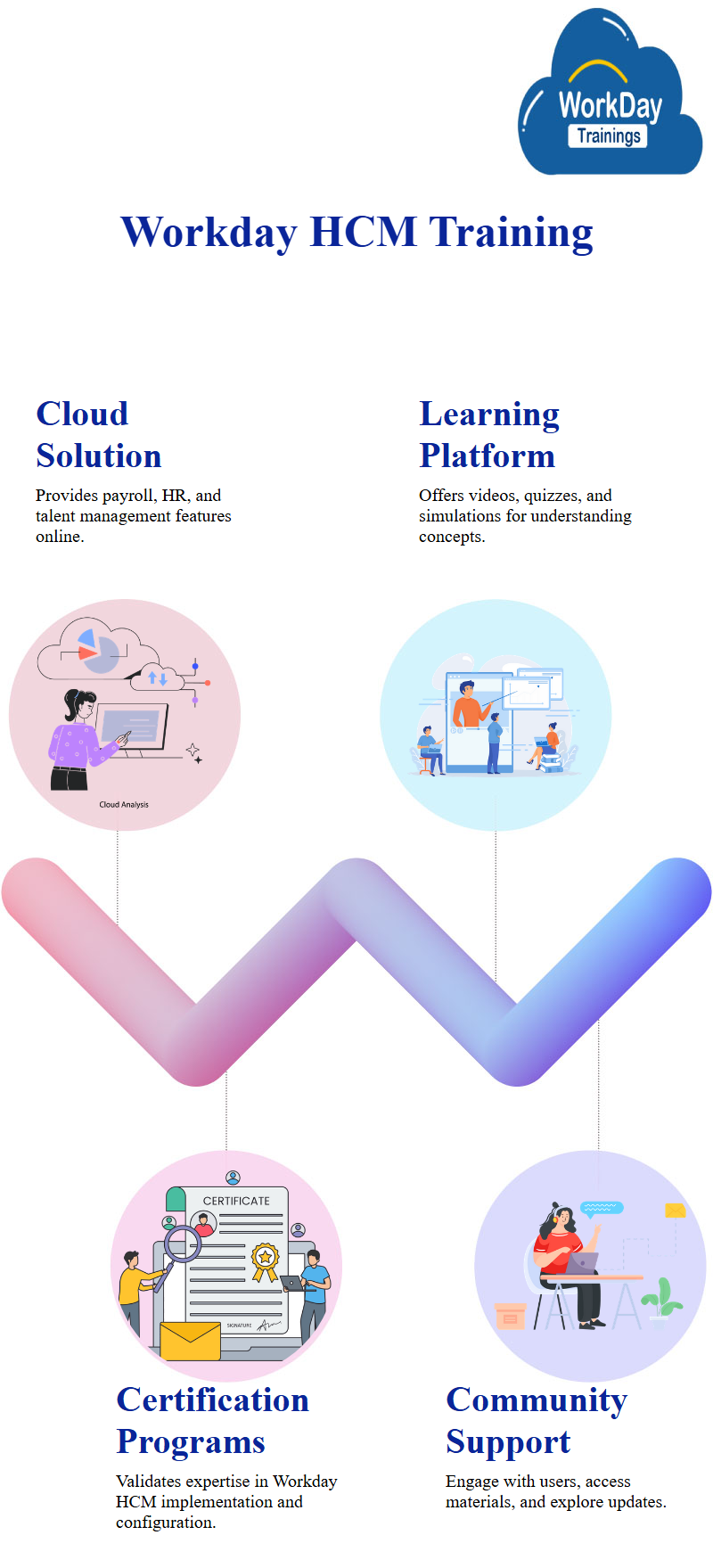
Workday HCM features and benefits:
Workday HCM provides an efficient platform to streamline HR functions and enables HR departments to make data-driven decisions more quickly. Utilising its real-time analytics and reporting feature, HR departments can make smart data-based decisions at lightning speed.
Mobile Access: Employees have access to their HR data on any device at any time with Workday HCM’s user-friendly user interface; employees can quickly and effortlessly view, access and modify their own records.
Talent Management: Organizations can leverage Workday HCM’s talent management features to increase employee engagement, succession planning and performance identification and development.
Workday HCM makes recruiting process management simple: from advertising open positions to welcoming new hires. Payroll and Benefits Management: Through Workday HCM businesses can streamline benefits administration and payroll administration operations while automating those functions as well.
Time and Attendance Monitoring in Workday HCM allows firms to more closely track employee hours worked while remaining compliant with labor standards.
For optimal data accuracy and flow efficiency, Workday HCM may also integrate with accounting or finance software systems for greater integration and more streamlined process flow.
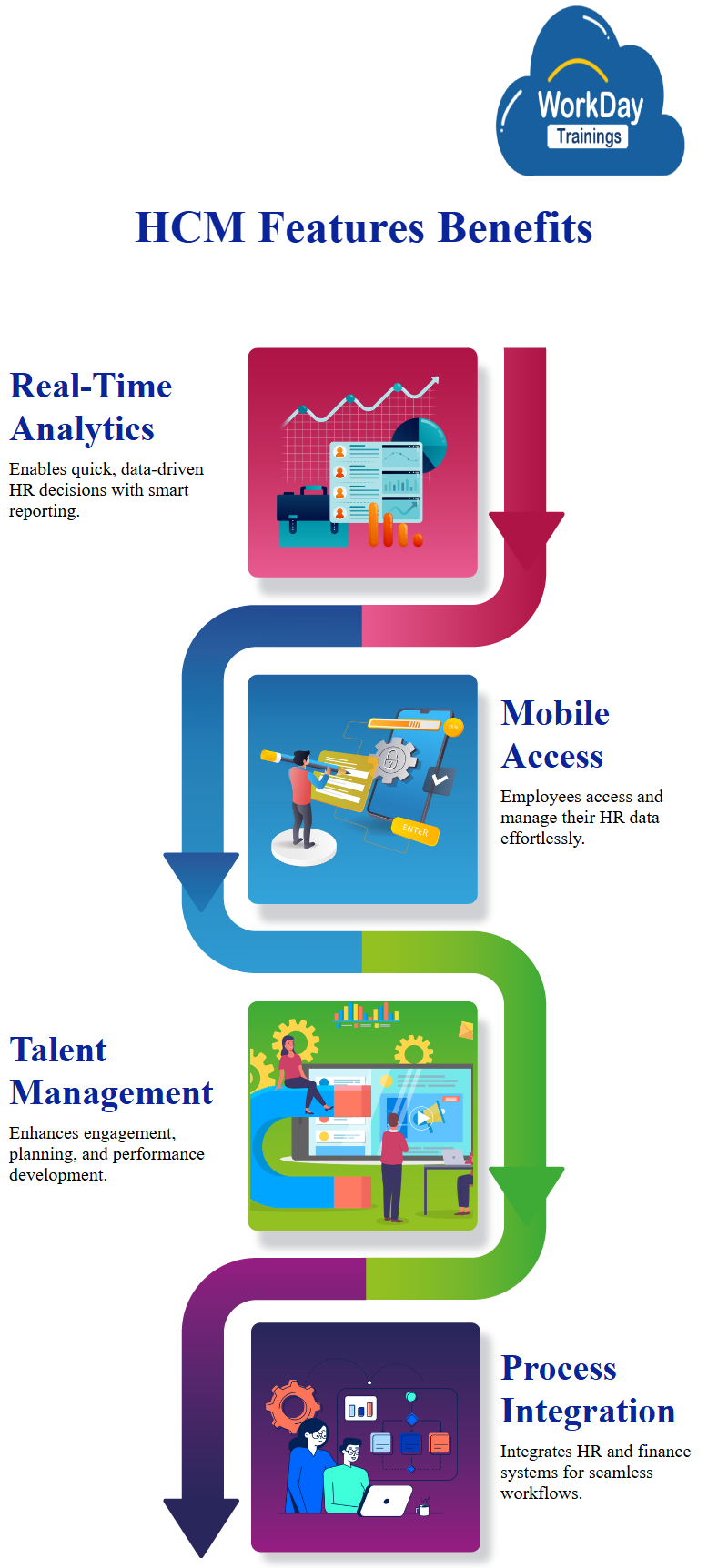
What is Workday HCM?
Human Capital Management Workday (HCM Workday) is an all-inclusive software package offering various human resource (HR) services to enterprises. Payroll processing, benefits administration, recruitment processes and HR analytics all fall within its offering of HCM solutions.
Human Capital Management Workday’s payroll module simplifies and automates employee payroll processing with features including payroll computations, tax compliance monitoring, time and attendance tracking and time and attendance monitoring all rolled into one solution.
HCM Workday’s Benefits Administration module assists companies in administering health insurance, retirement plans and paid vacation programs effectively and efficiently. It has capabilities like processing claims, keeping track of eligibility statuses and enrolling benefits into HCM Workday for employees.
HCM Workday’s recruiting module streamlines the recruiting process with job listings, managed resumes and candidate tracking all in a central hub for ease of use – simplifying recruiting. Requisition management and applicant self-service options also come standard.
Workday HCM Modules
Software systems known as HCM modules help firms manage employees in many ways, from payroll and benefits, recruitment and training through to performance evaluation and reward administration. Contained within larger HCM suites, HCM modules offer one central location from where to manage HR duties efficiently and cost-effectively.
Below is an in-depth breakdown of Workday HCM components:
Payroll modules offer multiple advantages to businesses: accurate salary calculations with all applicable deductions and taxes withheld are taken care of quickly, while prompt delivery of paychecks ensures fast pay outs to employees.
Benefits management becomes easy through this module’s platform; benefits enrollment, coverage options viewing and enrollment adjustments can all be managed easily through it.
Recruitment module’s features make job posting, applicant tracking and interview scheduling all simpler. There are tools provided for conducting background checks on candidates as well as organizing resumes and writing job descriptions.
Management of staff training programs – such as developing courses, creating schedules and tracking progress – is made simpler thanks to this training module. Furthermore, workers can quickly see which courses are available and review their own personal training histories.
Performance Management: The performance management module equips users with all of the tools necessary for setting objectives, tracking progress, assessing own performance and creating performance appraisals/goals/staff development plans as part of it’s functionality.
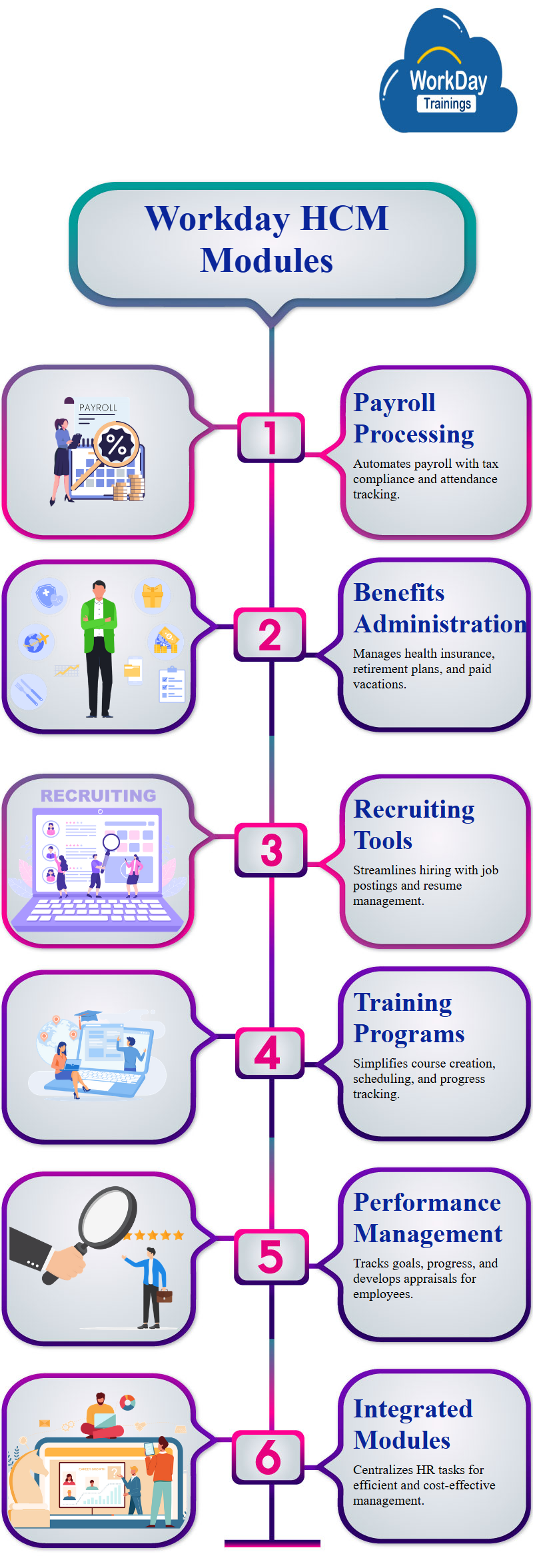
Workday HCM course online
My team and I would be more than glad to provide any further insight you require! Workday HCM provides organizations with an efficient software solution for human capital management; its core topics of payroll, benefits, time & attendance monitoring and performance measurement make this course invaluable to organizations of any size and scope.
Professionals interested in understanding more about Workday HCM and its potential advantages for their companies will find this self-paced course beneficial. Videos, interactive activities and quizzes among its many learning resources make this an engaging self-study program.
This course will cover an assortment of subjects, such as:
Design and Architecture for Workday HCM at NTU can facilitate payroll processing while meeting regulatory compliance, benefits administration, and reporting on them as well as time tracking of employees’ time spent on work as well as performance measurement/analytics/ reporting for each department or employee within your organization.
Privacy and Data Security Workday University offers this course through its training and education division to strengthen individuals’ abilities to oversee Workday HCM rollouts while offering operational assistance for their company workforce operations.
Prerequisites of enrollment on Workday University include subscribing to courses and creating an account on its website, where your course materials will become immediately accessible upon enrolling – giving you flexibility in starting studying whenever works for you!
Are You Professional Looking to Discover Workday HCM and See How it May Benefit Your Firm? The Online Course Can Be Helpful If so! The purpose is to promote best practices in HR management while offering practical, hands-on instruction.
Workday HCM stands for Human Capital Management; this software solution assists firms in managing both talent and human resources effectively. Workday HCM takes on various HR-related duties including payroll, benefits administration, time and attendance management, recruiting efforts, and talent management effectively and user-friendly cloud software solution provided by Workday.
Implementation of Workday HCM was undertaken to increase operational efficiencies and simplify HR procedures. As it utilizes a central repository to hold human resource data, accessing it becomes simpler while real-time analytics allow organizations to make data-driven decisions using real-time reporting capabilities of Workday HCM.
Workday HCM stands out among competing HR software with its mobile features; employees may easily view their personal information – pay stubs and benefits packages – from any location at any time using its convenient design for viewing them remotely on mobile phones or other portable devices.
Workday HCM offers compliance and regulatory services such as payroll tax computation and reporting, benefits administration and data security – just to name a few of their compliance and regulatory services.
Workday HCM is an outstanding HR software solution that assists businesses in better managing their personnel and human resources.

Workday training in India:
HCM, refers to how companies monitor and develop the employees in their workforce. Instead of taking place within traditional classroom environments, online HCM courses utilize the Internet in providing their curriculum.
Institutions across India offer Human Capital Management courses online. Topics often covered in these programs include recruitment and selection processes, employee relations issues, payroll benefits administration and performance evaluation.
India boasts some of the most sought-after HCM courses online:
Recruitment and selection, employee relations, salary and benefits administration, and the Certified Professional in Human Resource (CPHR) certification program are just a few topics included in the Indian Institute of Personnel Management (IIPM)’s (IIPM) curriculum.
Indian colleges that provide Master of Human Resource Management (MHRM) programs include the Xavier Institute of Management in Bhopal and the International Institute of Management in Bangalore.
Institute for Human Resource Management (IHRM) offers an IHRM Certified Human Resource Professional (CHRP) curriculum which features classes on employee relations, performance management, and recruitment and selection processes.
Participate in the Professional Development Program in Human Resource Management offered by the Indian Society for Human Resource Management (ISHRM). Coursework features modules on employee interactions, performance evaluation, and recruitment/selection.
This list does not represent all available HCM courses online in India; to make sure the right program fits with your goals and needs it’s essential that you consider its provider, eligibility requirements, course offerings as well as course offerings before selecting one.
Workday HCM Online Training covers multiple subjects, such as:
Configuration, setup and initial deployment of the system involving data migration/load, user permissions/roles management/migration as well as time/attendance payroll management as well as benefit administration (for management of benefits as well as payroll), independence portability analytics reporting to ensure compliance and safety are the objectives.
Participants enrolled in HCM online training in India typically access course materials, videos, and assignments via an online learning management system so they can work at their own speed.
Training times could range anywhere from one to several days depending on the trainer and difficulty level, with courses lasting anywhere between weeks to months in duration. Once complete, participants usually receive a certificate as evidence of their achievement.
Employees working in human capital management who want to increase their knowledge and gain practical experience would do well to take advantage of India’s online training courses for HCM.
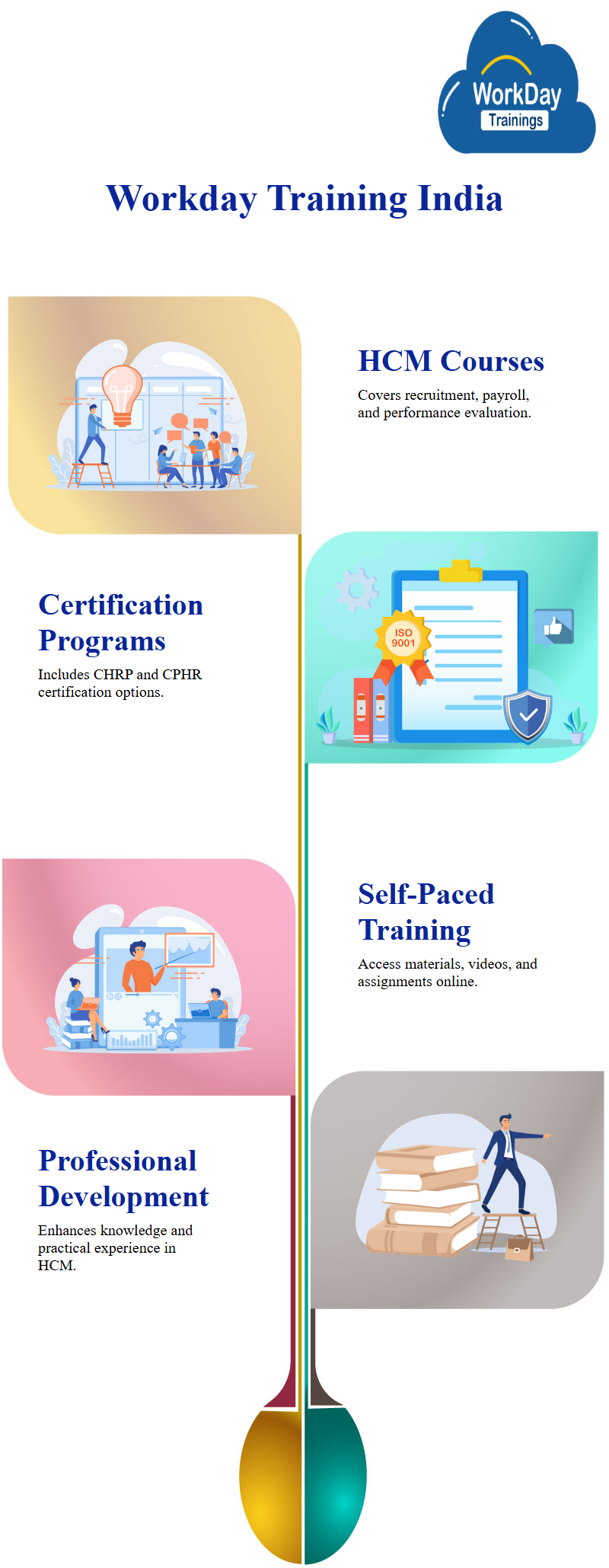
Employee Compensation and Merit Plans Course Overview
The curriculum outline will cover the product’s capabilities, such as providing water information, Workday salary allowances, total Workday costs for the Workday company, and the merit plans or bonus plans assigned to each worker.
The curriculum will also cover the Workday course outline, donation, and prospects after completion.
The course material will cover the Workday course outline, donation, and prospects after completion.
The product can provide information on employee Workday compensation, Workday salary allowances, total Workday costs, company affiliations, and various merit and bonus plans.
Staffing Models and Job Profiles
The creation and filling of jobs and positions depend on the chosen staffing model. There are two main staffing models: Workday Position Management and Workday Job Management.
Job profiles are essential for HCM Workday software to create Workday job opportunities, outlining the responsibilities, tasks, qualifications, and skills required for the job.
Understanding Tenants in Workday:
The Tutorial discusses the concept of a tenant in the Workday system, which is a standalone instance of the company’s information that can be configured and used for specific purposes.
A tenant is essentially a person who rents a house and receives permission to use the property for a period of time. However, they cannot make structural changes to the property, such as changing the location of windows or toilets, or modifying the layout of the house.
Using the GMS Tenant for Training and Testing in a Real-World Environment
The handbook explains the importance of using a system called the Global Modern Services (GMS) tenant or GMS tenant for Workday training and Workday demonstration purposes.
A GMS tenant is a fictitious company where data is preloaded for a specific company. Logan, an employee of the fictitious company, has all the permissions to perform tasks and run reports. To access other tasks, users must proxy as Logan. In the real environment, real employees from the company are not visible. The Workday GMS Tenant allows users to access data and perform tasks without needing to log in as someone else.
The handbook then moves on to search for workers like Anthony Reed and Jack Taylor, who are assigned to customer service associate positions in New York. The Workday GMS Tenant ensures that the data is available for real-world testing and comparisons.

Configuring Workday for Business Requirements
Workday operates in a certain manner, and understanding how it works will help configure Workday for business requirements.
However, it is essential to note that structural changes to the system are not possible, as they require the use of a supervisor to hire workers. This is a given and must be done by the supervisory organization.
Workday Tenant Management System (GMS)
Workday is a standard system for managing reports and locations across various systems and companies worldwide. It is called a tenant because it allows users to customize their experience to their specific needs.
A GMS tenant is a dedicated tenant that contains data for a specific company, such as global modern services, Inc. This data is used for Workday training and Workday demonstration purposes.
Navigating the Complexity of Workplace Organizations
Workers are tied to multiple independent organization types, each with a different purpose. They can be part of a department, company, location, cost center, or region.
However, it is typically not possible for an employee to be part of two different departments at the same time. One worker can be classified in a Workday supervisory organization, cost center, region, or company.
There can be an overlap between different types of organizations, such as people from different departments in the same location.
For example, a sales team may be present in different locations, but not necessarily in the same department. This complexity of organizations allows workers to be members of multiple independent organizations with different purposes.
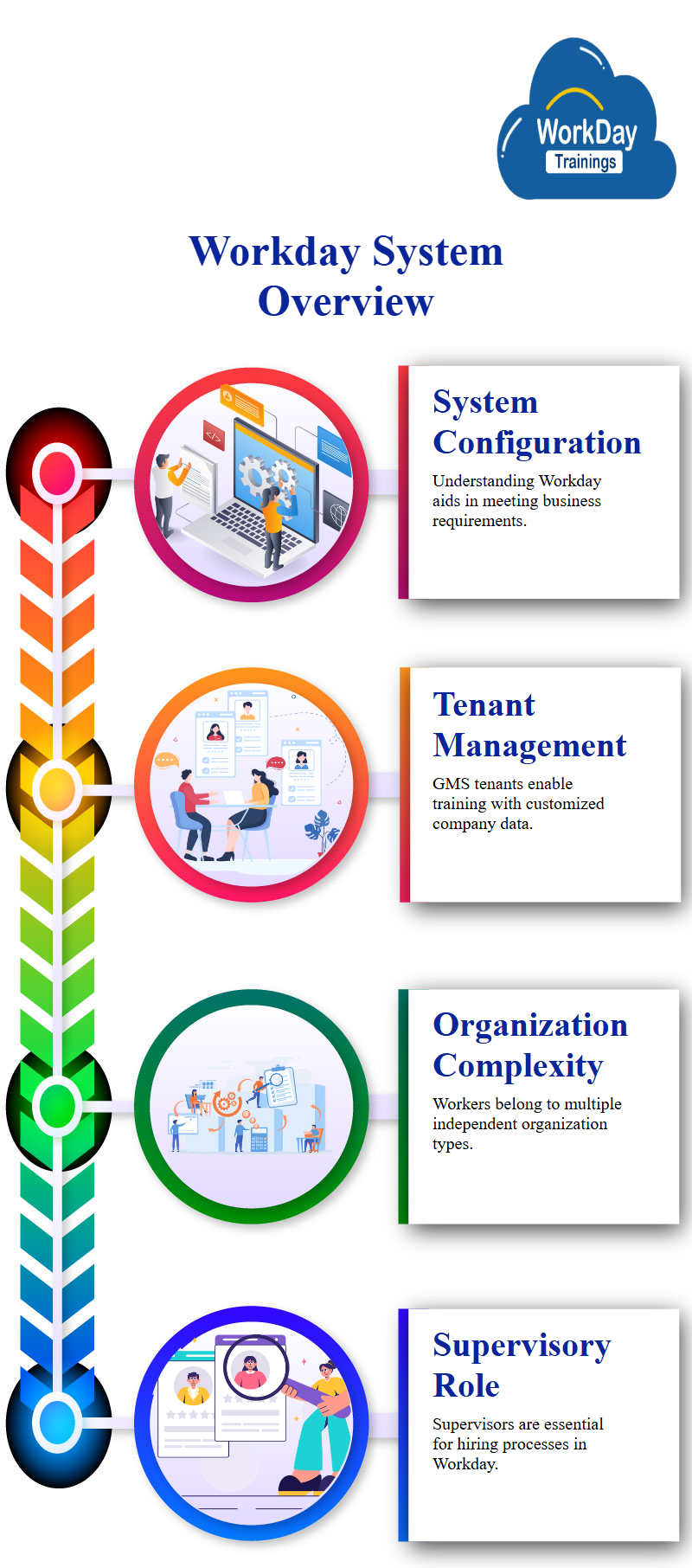
Customizing Built-In Organizations for Effectiveness
The functionalities of built-in Workday organizations vary depending on the purpose and the organization’s size. To create an organization subtype, users can select the department they want to mimic in the real world.
If the organization has its URL, such as a website, it can create an external URL with a name and an actual URL. The primary location of the organization is typically the company headquarters, such as Chicago.
Assigning Roles and Workday security Issues
The Tutorial is choosing a Workday staffing model, specifically Workday Job Management, and is defining roles for the organization. They are noticing numerous unnecessary roles created, which they decide to leave.
They then add a new role for a manager, Logan McNeil., and assign it to him. However, they encounter issues with the assigned roles, which are related to Workday security. The Tutorial tries to understand why this is happening and tries to eliminate some of them. They also try to find a solution to the issue, but they are unable to find a solution.
The Tutorial suggests that the Workday issue might be due to the creation of Workday roles for everyone, which they believe is not necessary or correctly done. They plan to try to remove some of the Workday roles, but they are unsure if the Workday issue is due to changes in the location.
View Organizational Structure for Future Hires
The Chicago 2 new app allows users to view their organization structure as of a future date. The primary location is Chicago, and the organization is created with a Workday Supervisory Organization reference.
To change this, users can go to related actions and select Workday integration IDs. The organization’s name should be the same as the organization’s name, preventing duplicates. The type of organization created is the person who is registering. The view as of function allows users to view the organization as of a different state, such as in the past or future.
The Workday advantage of this is that users can view the Workday organization structure as of a future date, as they are opening a new thing at once.
For example, if a company is hiring a few workers, they can view the Workday organization structure as of the first of June 2022, expecting all workers to join. This allows users to view future-dated hires and plan their hiring process.
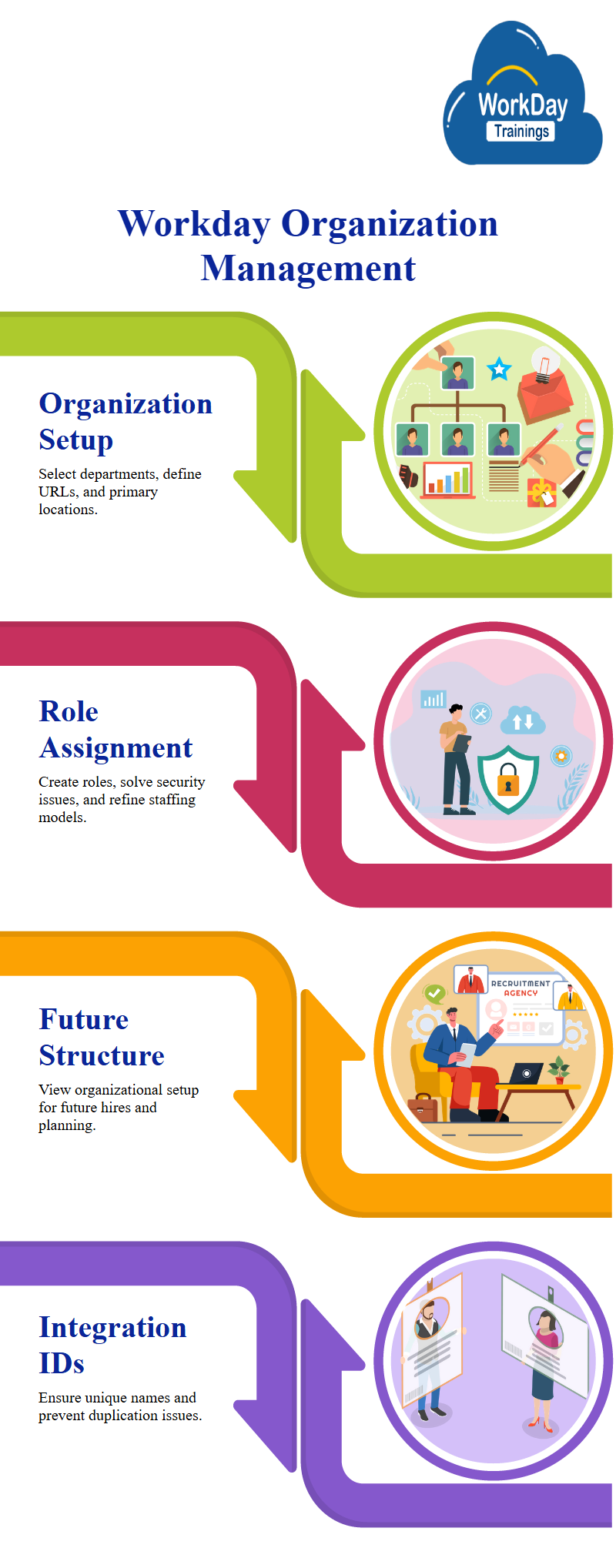
Organizational Structure and Roles
An old organization was created in 2010 and has experienced numerous changes over the years. As of January 2021, the organization structure has a limited history, but it can be viewed as of a past effective date. The details tab provides information on the availability date, supervisory type, department type, and code.
The visibility is set to everyone, and Workday Job Management is chosen as the staffing model. The roles are assigned, including manager manager, to Logan McNeil.
Effective Dating in the Workplace: Managing Organizations with Precision
Effective dating is important for various tasks in Workday. For example, when hiring a new worker, the effective date should be the first of June. However, if the entry is made today, the worker will only be visible on or after the first of June. Effective dating can be done in the past, current date, future date, or today’s date. Most tasks can be done with the past, future, or today’s date as the effective date. Effective dating is essential for managing and managing the organization effectively.
Tracking Organizational Changes with Reorganizations on iPad or Mac Launch
The narrator is launching an iPad or Mac on November 1st, 2021. They are discussing the importance of creating separate reorganizations for tracking changes to the organizational structure.
A reorganization is an event that tracks changes to the structure, and if you make more changes with a different effective date, create another reorganization.
There is no limit to the number of reorganizations you can create, but use them judiciously.
Location-Based Reporting and Reorganization in Remote Workday Work
There is an importance of creating reports based on location, as each worker has their own location. The COVID-19 pandemic has led to increased remote Workday work, with many organizations creating locations like New York remote.
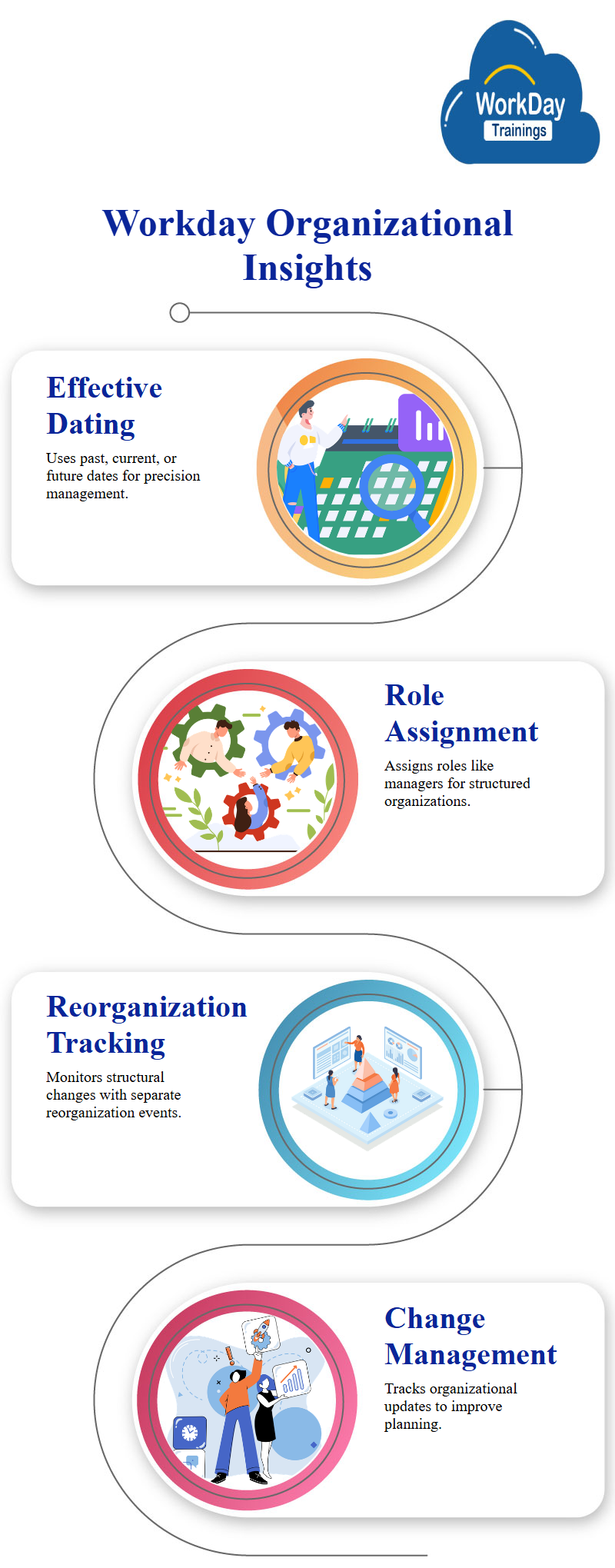
The Tutorial also discusses the concept of reorganization, which is a one-time process for tracking changes. The Tutorial suggests that if changes are effective from a specific date, they should be grouped into one reorganization, while those with different dates should be grouped into two reorganizations.
For example, if the team is working on the Apple iPhone 13 on September 1st, 2021, and the team on the iPhone 14 on September 1st, 2022, they should be grouped into one department with the effective date of September 1st, 2021, and two reorganizations for the next one.
This approach ensures that the organization’s data is not duplicated and that the team is properly managed and managed.
Workday’s Physical Locations for Business Asset Tracking
Workday creates physical locations for new companies, such as those in New York and Chicago, to track business assets and physical workspaces.
These locations are logical entities for the actual physical workspaces or buildings and are used to default certain data values like date formats, time zones, and currencies.
The Structure of Global Organizations with Multiple Legal Entities and Managers.
Global organizations are structured in this way, with supervisory organizations where employees from different countries Workday report to one manager.
The Workday manager may be in the same country or in a different country, and if they are associated with a different company, they will be associated with the different legal entity.
Customizing Qualifications for Job Positions
The person creating the position is able to define various qualifications in the qualifications tab, such as skills, Workday education, Workday languages, Workday certifications, Workday work experience, competencies, responsibilities, and training.
The B A qualification is filled, but it is not related to the job profile. In the Workday Position management, you can define these parameters on your own. For example, if you want an M S, Master of Sciences, you can overwrite the qualification from the job profile.
You can also define Workday certification requirements, such as a training manager Workday certification Workday course from the training management institute. The specific specialty you want is functional expertise.
Task for Steve Morgan: Review Job Qualifications
Steve Morgan is on behalf of Steve and has his task waiting for his action. He can find it in the list on the front page or by clicking on the inbox icon on the top right. The job posting title is “Ww training administrator” and the job posting title is “London, rally”.
The qualifications are V A, and the qualifications are the same as when Logan created the position. Steve can now review the qualifications and Workday work experience.

Job Management and Hiring Restrictions
Workday Job Management provides the least control over the definition of individual positions, but it does have control over hiring restrictions and qualifications. Hiring restrictions are set at the organization level or supervisory organization level, allowing for one-size-fits-all all.
Qualifications are set in the job profile and included in the hiring restrictions. This is particularly useful for Workday organizations that define broad job requirements and rely on staffing workflow and approvals to control the number of workers.
The hiring process moves from creating the position to hiring, allowing for hiring as many workers as needed. Job management does not require creating separate open positions for each job, as one set of restrictions applies equally to all jobs.
The Importance of Rule Logic in Management Systems
The sequence of rule conditions is important, as it determines the entire management level. However, the way the rules are written and the logic used is also important. If one row is moved, it can mess up the entire logic.
W W Rule: Eligibility Criteria for Compensation in the USA and UK
The task is to create a compensation eligibility rule, which should be called W W, followed by managers in the USA or supervisors in the UK. The rule should be named accordingly, such as managers in the USA or supervisors in the UK.
Using Brackets for Grouping in Rule Conditions
The topic highlights the importance of using brackets to group rule conditions together, as they allow for more complex rules. However, changing the sequence of rule conditions is not necessary as it still ensures that all managers in the USA or supervisors in the UK are included.
Rules of Workday managers in Workday of US and UK.
Excel Task: Find US Manager and Select UK Supervisors.
The Workday manual describes a task in Excel to find a manager in the USA and select supervisors in the UK. The field management level compensation is used, and the task involves selecting a manager from the selection list and scrolling down to find the correct one.
The task also includes adding a condition that checks for the location, specifically the country of the primary location. The field is a standard Workday-delivered field.
The task involves using the country of location field to find the country manager in the USA. The document also discusses the use of brackets and up and down arrows to move the rule to the top or bottom of the list.
The sequence of the rule conditions is considered important, and the order of the conditions is considered.
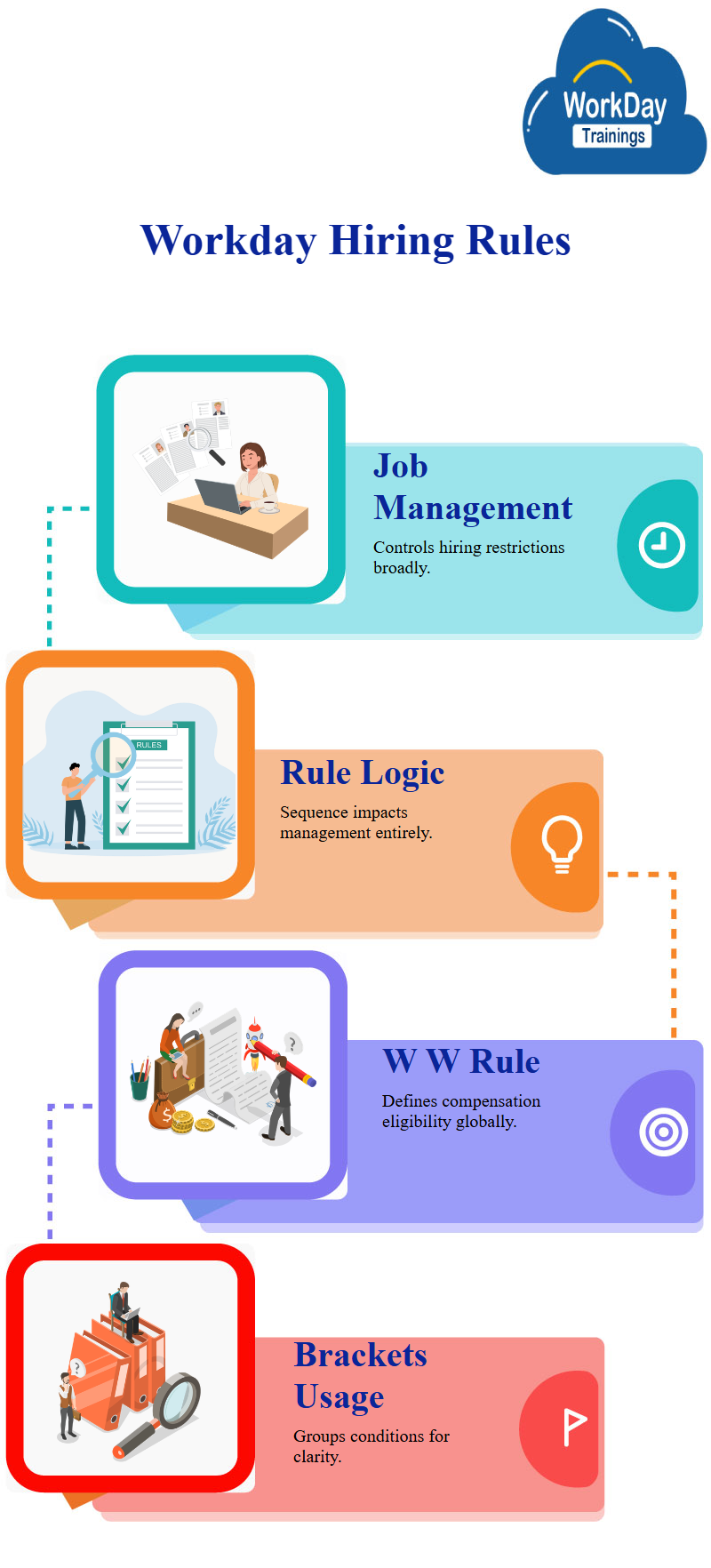
Adding Rows in a Table: Top Workday vs Workday. Bottom Options
The document also discusses the use of the add row at the top and add row for each row options. The first option is to use the add row at the top, which inserts a row immediately below the existing row. The second option is to use the add row button at the top to insert a row at the bottom.
Complex Eligibility Rules Spreadsheet
The document describes a spreadsheet that allows users to create complex eligibility rules for managers in the US or supervisors in the UK. The rules can be created using various fields, such as management level, country of location, and supervisor. Users can copy and paste text into the desired field, and fine-tune the rules with brackets.
Testing Compensation Eligibility Rules in the Workplace
To test the rules, one can go to the compensation eligibility view of eligible workers or perform a test for specific workers. If the worker is part of the list, the result will be either yes or no.
It is recommended to perform both positive and negative tests. The article concludes by discussing the use of eligibility rules in the context of the organization hierarchy.
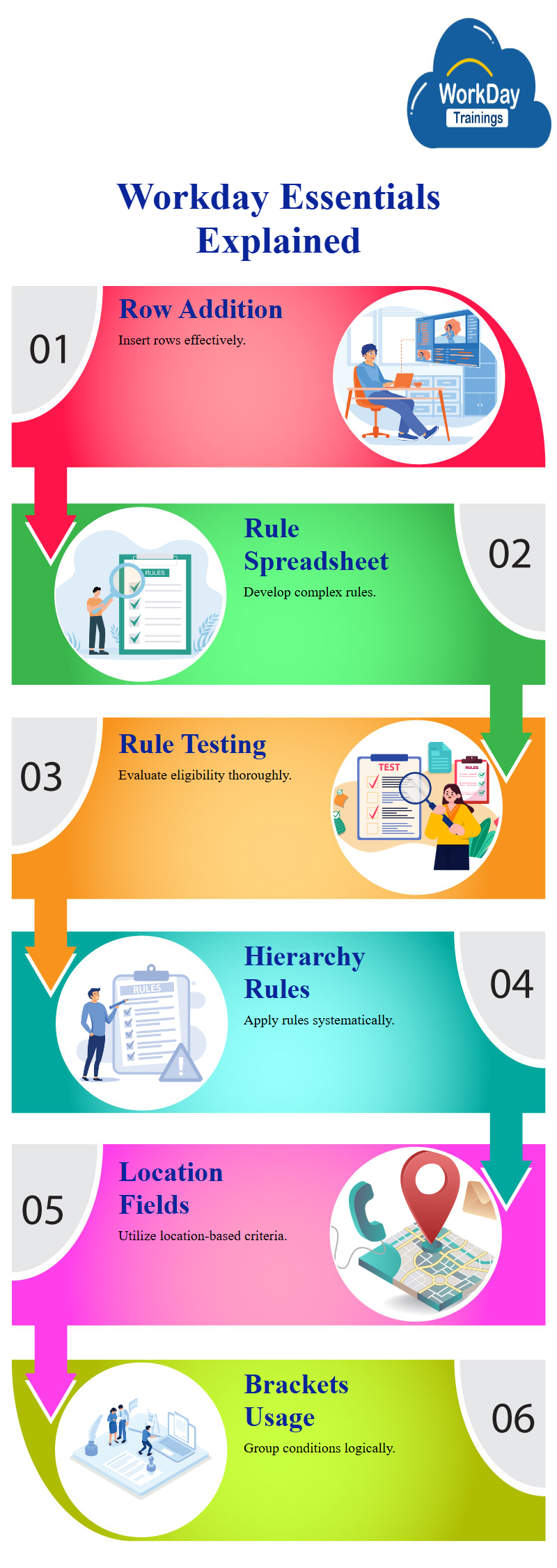
Workday job application Methods and Workday costs
Existing employees can apply to internal career sites, while contingent workers may also apply for positions. Community networks like Facebook, LinkedIn, Spalk, or Twitter can also be used for candidate applications.
Agencies can specialize in headhunting, but they typically charge a fee of around 8% to 8.5% of the candidate’s compensation.
Campus Job Fairs: Connecting Students with Career Workday Opportunities
Job fairs are campus-sponsored, commercial professional events where students apply for job openings. These events can be held in universities, colleges, or educational institutions, and can be advertised through broadcast, outdoor, print, or employee referrals. Advertising can also be done on corporate websites or TV media.
Flexibility in Workday Staffing: Staffing Restrictions and Pre-Hire Records
The material discusses the importance of allowing override of restrictions on staffing events in Workday HCM. It explains that recruiters or hiring partners cannot change the values automatically in Workday hiring restrictions, such as part-time, full-time, location, or worker type.
However, in large organizations, this option is unchecked to make the system foolproof. The booklet also discusses the difference between a pre-hire object and an employee object in Workday HCM.
The pre-hire and employee are separate objects, but they are related to one another but not one and the same. Workday HCM offers three ways to create pre-hire records: manually, through an integration with an ATS, or using the Workday recruitment module.
These methods allow for flexibility in the hiring process and ensure that the system remains foolproof. The booklet concludes by highlighting the importance of understanding the differences between pre-hire and employee objects in Workday HCM.
Hiring Restrictions in Supervisory Organizations
A worker can only be hired into a Workday supervisory organization. However, the hire reason is not a required field, and it is not mandatory. When hiring into a position, position restrictions default in and cannot be changed.
A global parameter that controls whether this is true or not is the option to allow override of restrictions on staffing events.
Pay Range and Segmentation in Compensation Workday Analysis
The Workday manual discusses the concept of pay range and segmentation in compensation Workday analysis. It explains that a grade gives information about the pay range, and a segment indicates the pay rates. For example, if a person is in segment S two, it means they are making less than average. This is a midpoint, meaning they are below the median.
The Core Connector Worker: Detecting Worker Information Changes
A core connector worker is a package connector that exports worker data changes from work day in XML format. It is not specific to any third-party system or Workday application, but rather more generic and popular.
The core connector worker detects changes to worker information, such as hiring, promotion, transfer, termination, contact information, and Workday compensation information. It can generate a file containing the changes, which is useful when transferring data between systems.
The core connector worker is designed to work with worker data changes and is capable of detecting changes by monitoring a transaction log.
It is a powerful, versatile, and widely used tool for detecting changes in worker information. The core connector worker is used in integrations between work day and external systems, and its main purpose is to detect changes in worker information.
In interviews, candidates are often asked about the change detection process of a core connector worker, as it is a common interview question. The core connector worker is designed to be versatile and effective in detecting changes in worker information.

Harsha
New technology, let's explore together!